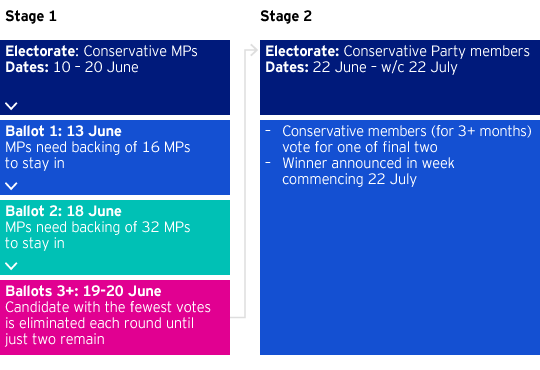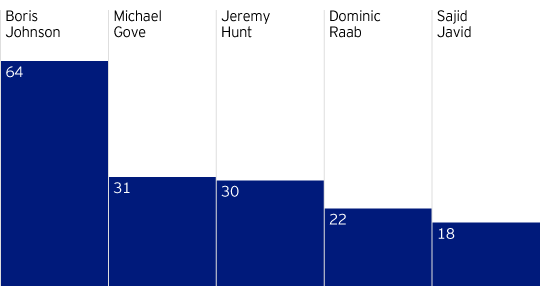17 Jun 2019
And they’re off. The race to become the next Conservative Party leader and UK Prime Minister has officially started. Who might win and what are the implications for Brexit?
After months of jockeying, the formal race to succeed Theresa May as Conservative leader and Prime Minister is under way. The 1922 Committee has announced the long-list of candidates whose names will be on the ballot paper for the first round of voting on Thursday. Candidates needed the support of 8 Conservative MPs to be nominated. Sam Gyimah, the only candidate explicitly advocating a second referendum, was forced to withdraw due to lack of support. A total of 10 candidates qualified for the ballot paper:
The contest consists of two stages: a series of ballots of Conservative MPs to whittle down the candidates to the final two; followed by a ballot of c.120,000 ordinary members of the Conservative Party to determine the winner.

The contest is currently a battle between two sides of the Conservative Party: harder-line Brexiteers (such as Boris Johnson and Dominic Raab); and more moderate current Cabinet ministers (such as Michael Gove, Jeremy Hunt, and Sajid Javid). Until the weekend, the assumption in Tory circles had been that the final two candidates would be Boris Johnson and Michael Gove. However, Gove’s admission over the weekend of previous drug use has stalled the momentum of his campaign, giving an edge to his closest rival, Jeremy Hunt. In the last few days, Hunt has continued to add names to his list of MP supporters, including a further two Cabinet Ministers – the Pensions Secretary and the Defence Secretary. However, Hunt’s support is heavily skewed towards Remain-supporting MPs with just four Leave-supporting colleagues backing him for PM – something that could count against him if he makes it to run-off stage.

Source: FT.com, as of 11/06/2019. Publicly declared supporters.
A year ago, many Conservative MPs would have said that Johnson stood little chance of becoming the next leader having alienated too many of his colleagues and failed to impress as Foreign Secretary. However, recent resignations and defections among Conservative MPs, combined with Brexit paralysis and the deeply divided nature of the Party, have convinced many that the next general election is not too far away. And the meteoric rise of the new Brexit Party has persuaded them that they need as the next Conservative leader someone who can both neutralise the threat posed to many Conservative seats by Nigel Farage and take on Jeremy Corbyn. As a result, many MPs have already concluded that Boris Johnson represents their best hope of retaining their seats and a Conservative government in office.
At this (early) stage, with a substantial lead in the number of declared MP supporters, and the greatest following among grassroots Conservative members, the contest is Boris Johnson’s to lose. However, the history of Conservative leadership contests demonstrates that the favourite rarely wins and that candidates have a tendency to self-destruct on the campaign trail. Conscious that he has most to lose, and of his propensity for gaffes, Boris Johnson’s team have kept him away from serious media scrutiny so far. But that will only work for so long, and calls are already increasing for him to subject himself to greater scrutiny.
The most interesting part of the first stage of the leadership contest will come next week when the votes of those candidates knocked out of the contest are distributed among the remaining contenders. Although Boris Johnson is well-ahead of his rivals, he is currently some way short of the magic figure of 107 backers which would guarantee him a place in the final two, meaning there is still all to play for.
The top five candidates have all pledged to renegotiate elements of the Withdrawal Agreement focusing principally on changes to the Northern Ireland backstop. Both Boris Johnson and Dominic Raab have pledged to take the UK out of the EU without a deal if one is not agreed by 31st October. And Michael Gove, Jeremy Hunt and Sajid Javid have all said they would opt for a ‘no deal’ Brexit if the only other available option were to remain in the EU.
However, whoever is the new PM will face exactly the same constraints as Theresa May:
In addition, the new leader will have just three months from the time of their appointment until the extended Article 50 period expires to negotiate, agree and ratify a revised deal. For these reasons, unless EU leaders are willing to give ground on the backstop (and all the signs are that they aren’t), the chances of agreeing a new deal by 31st October remain small.
With each of the top five candidates willing to entertain leaving without a deal, the chances of a ‘no deal’ exit are increasing. There has been considerable speculation in recent weeks that the Commons’ Speaker and Remain-supporting MPs will find a way to allow MPs to legislate to block a ‘no deal’ exit. However, so far, no reliable mechanism has emerged. To make their task harder, once the new PM is installed there are likely to be just six weeks during which the Commons will sit before the Halloween deadline. Whatever constitutional innovation they are preparing will need to be tested and implemented rapidly if it is to have the desired effect.
Meanwhile, EU leaders will be focused on the changing of the top-tier of positions in Brussels – in the Commission, in the EU Parliament and in the European Central Bank – and will have little appetite for engaging in further Brexit negotiations with the UK when they have already ruled out changes to the Withdrawal Agreement.
Therefore, whoever takes over as PM will face an immensely difficult task in achieving a different outcome to Theresa May. Much will depend on whether MPs are able to find a way to prevent a ‘no deal’ exit. If they are, Brexit paralysis is likely to continue until such time as a general election or second referendum remain the only viable options. If they aren’t, avoiding a ‘no deal’ exit will depend on the EU giving ground on the Northern Ireland backstop – something it will be desperate to avoid.
10 June Nominations day (nominations require support of 8 MPs)
13 June First ballot (candidates need 16+ votes to stay in)
18 June Second ballot (candidates need 32+ votes to stay in)
BBC Tory leadership debate
19 June Third ballot (lowest-ranked candidate eliminated)
20 June Remaining ballots until two candidates only remain
20-21 June European Council meeting: review of Brexit progress
22 June First Conservative membership hustings
2 July Inaugural plenary session of new European Parliament
w/c 22 July Next Conservative leader and PM to be announced
29 Sept Conservative Conference begins. Ends on 2 October.
17-18 Oct European Council meeting
31 Oct Extended Article 50 period expires
12-13 Dec European Council meeting
Important information
All data is as at 07/06/2019 and sourced from Invesco unless otherwise stated.
Where individuals or the business have expressed opinions, they are based on current market conditions, they may differ from those of other investment professionals and are subject to change without notice.